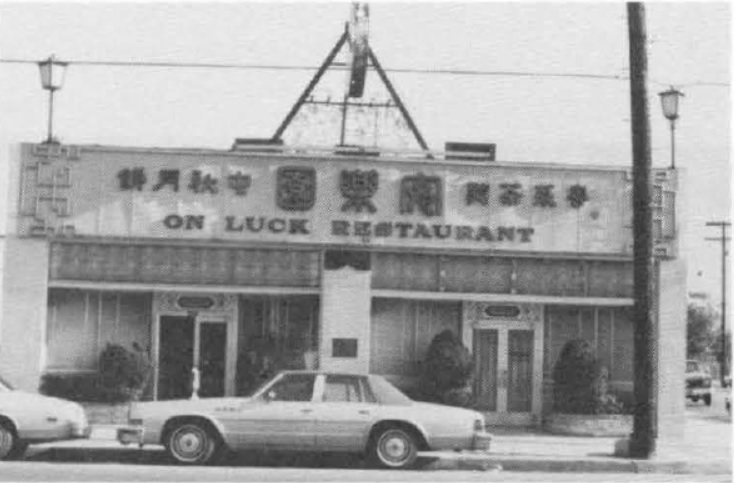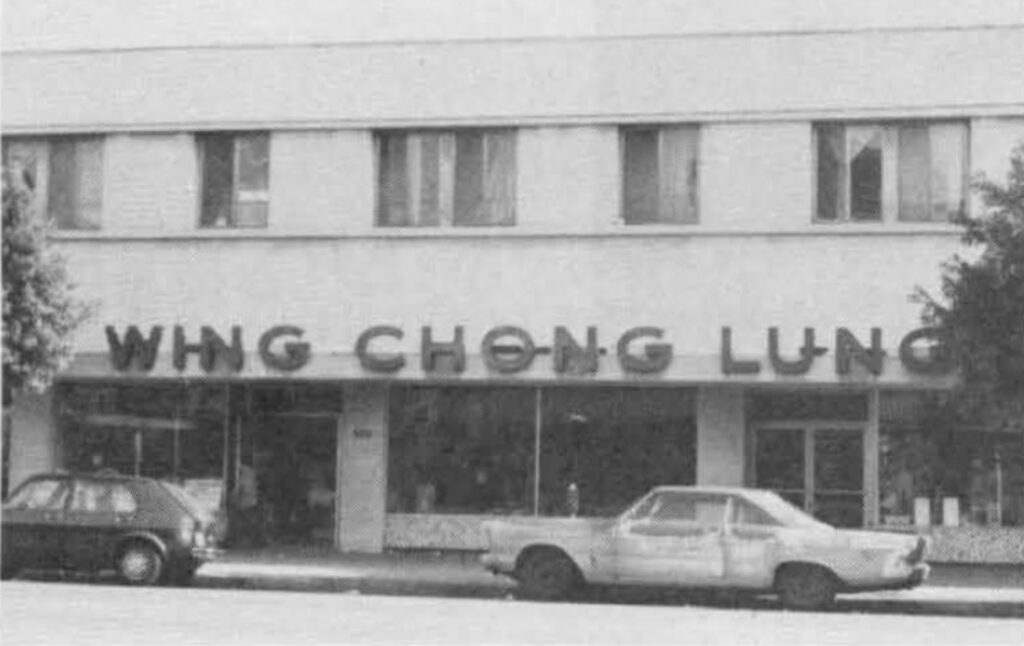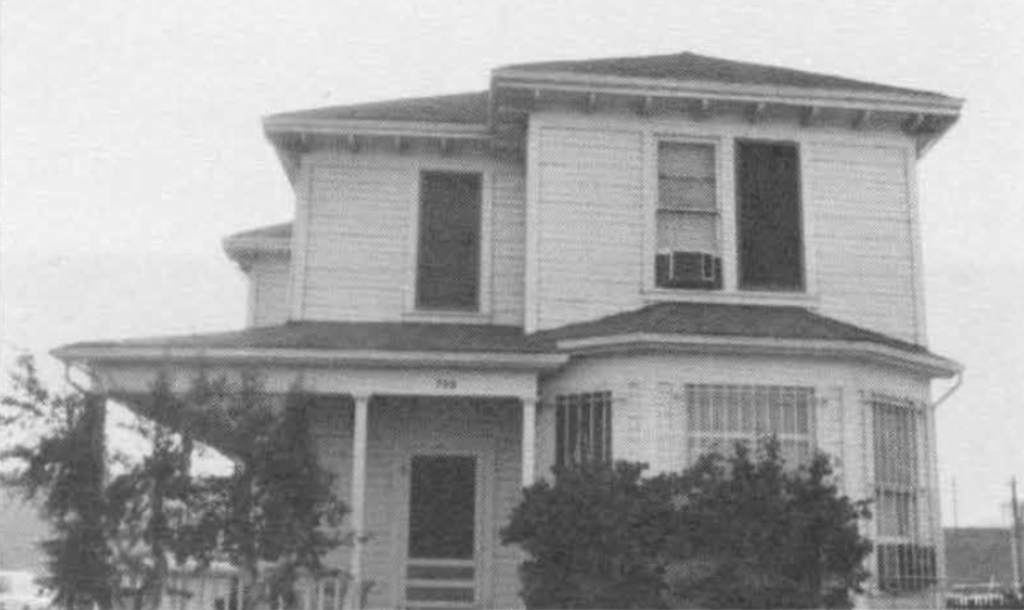
One of the oldest restaurant locations in the Market Chinatown on San Pedro and 10th Streets. Previously known as Great Eastern.

One of the oldest wholesale-retail markets.

Old wooden frame house in the Market Chinatown. This dwelling is typical of the many homes which have been tom down.

Corner of San Pedro and 9th Streets.
Grandpa had 10 acres ·in Cudahy raising asparagus, and had a small peach orchard. We raised chickens and goats and I had to milk the goats. We were one of the few who owned property because Mom was born here. Sixty years ago, the Chinese, Japanese and Italians were doing most of the farming.
George F. Woo
Produce Dealer
The Chinese were good farmers. Many had a farming background in China where eking out a crop from poor farm land could mean the difference between eating and starving. When other farmers gave up trying to raise celery in the low flat land of Huntington Beach, the Chinese farmers went in, drained the land and with proper cultivation showed that celery could be successfully grown there. As a result, the price of land tripled in Huntington Beach.
Asparagus was another good crop. At one time the Chinese grew 80% of the asparagus in the Los Angeles area. An asparagus association was formed by the Chinese to collectively market the asparagus crops.
Sam Chang
Farmer
It was not too difficult to start a produce business on a small scale.
Those days you could start a business for $150 to $200. I started in the produce business single handed in 1927 with a stall and a $70 used truck. Gas was 15¢ to 18¢ a gallon. I went to Maywood and Downey to the small 10 to 20 acre farms to buy potatoes and onions packed in small boxes. A truck load was 150 boxes. If I made 5¢ to 10¢ a box, it was something.
George F. Woo
Little capital was needed to start a business. The farmers would bring in the produce and were paid only after the produce was sold. Other times, the produce house sent trucks out to the farm to pick up the produce. Rent was only $35 then.
Keong Lee
Produce Dealer
The larger produce houses generally consisted of a partnership. A partner would work; sell his share to someone else; go back to China; return and buy back into the same business or some other business when someone else was leaving.
The business was not without risk. Sometimes, a produce house would heavily finance a farm and when the farm went under, so did the produce house.
Produce business is a gamble. At times you can lose money and other times make 5 to 10 per cent profit. Pricing depends on supply and demand. If the health department inspecting the produce found chemicals or insecticides, a red tag is issued and the produce is dumped. We would show the tag to the farmer and not pay him. Sometimes we buy outright from the farmer. When that happens, we lose money.
Keong Lee
In 1924, an additional $100,000 capital was raised to extend the market area to Twelfth Street. By this time, the number of Chinese in the produce market was slowly starting to decline. The horse and wagon was gradually being replaced by small trucks. In 1929 horses were no longer permitted to enter the City Market yard because of City health regulations.
The produce business hours were long and hard. Much of the work involved sorting and repacking the produce into a more attractive package to bring a higher price.
Sometimes we go to work about 7 P.M. and work until noon the next day. There was no union those days.
Wong Chun Ning
Produce Dealer
During December to March, we partners put in 18 hours or more a day, 7 days a week. On other months, we worked 12 hours a day.
Keong Lee
Work was hard. It was outdoors. When it rains, you still have to work.
Suey Yen Wong
Produce Dea
Produce workers were paid $20-$25 a week. During the 1930s Depression, the workers pay scale was dropped a little to $17.50 a week. The Depression did not affect the produce market much because people still had to eat.
In 1937, the workers went on a short strike, organized and formed a union. Afrer that, an 8 hour day, 6 day week became standard. During World War II, the market went to a 5 day week to help conserve gasoline.
Wong Chun Ning
Many of the produce people lived around the market area. It was a common sight to see lines of trucks parked along the streets when the workers brought their trucks home at night.
Chuck Produce had two houses on 22nd Street near Stanford Avenue. Some workers lived in a back house. They had a large walk-in refrigerator in the yard for overnight storing of their produce overflow from the market.
Wayland Wong
Son of Produce Dealer
The Chinese Produce Merchant Association of Southern California was an active organization. Its membership consisted of Chinese produce dealers. It held monthly meetings, generally in a local restaurant. Dues were $7.50 a month. A recreation hall which always attracted a crowd was located at its headquarters on the second floor of the City Market. They had Tai Chi classes. Chinese New Year banquets and picnics were a big thing every year. In 1935, the Association helped the City Market put on a 25th anniversary celebration at the south end of the market. The stage show entertainment with a Chinese marching band attracted thousands.
When World War II broke out, the number of produce dealers at the City Market was about equally divided between Chinese, Japanese, and Caucasians. When the Japanese had to evacuate to the relocation camps, the remaining dealers agreed to each proportionately expand to fill the empty stalls.
This was the last upturn of Chinese involved in the produce business. After the war, many of the Japanese returned to the business. More and more Chinese old-timers were leaving or retiring from the market. Their American-born offsprings were starting to find chances opening in other fields with better working hours and did not want to follow in their elders’ footsteps.
Before the war, business was conducted on a cash and carry basis. After the war, it was credit.
The Chinese did not readily adapt to the new market situation. Their dealings were mostly with small groceries and restaurants in which they developed a close relationship. When their clients went out of business or changed hands, they did not aggressively look for new customers. While other produce companies were enlarging and incorporating, the Chinese ownership remained family oriented, mostly operating out of one or two stalls.
Wayland Wong
The Chinese did not like to merge with anyone. They like to be their own boss.
Harold Yee
Produce Dealer
The City Market area fell to despair. For a number of years, the actual ownership of the buildings was confusing. It took some years for the attorneys to straighten out the titles and reorganize the corporation.
The industry underwent a great change. Lift trucks replaced manpower. The big chain stores did more direct buying from the farmers and by-passing the wholesale produce market. Responsibility of proper produce packaging now lay with the shipper. Suburban growth had forced out the local farmers. Land that sold for $500 an acre in San Fernando Valley in 1937 was selling for $200,000 in 1957. Farms were being located farther out and produce was brought in by refrigerated trucks.
The 1950 Chinese Commercial Bureau Directory listed 36 Chinese-owned produce companies in Los Angeles.
PRODUCE COMPANIES – 1950
Ace Produce Co., 1066 S. San Julian St ……………………………… PR 0800
Bright Star Produce, 10407 Santa Monica Blvd …………….. AR 3-0769
C.F. Produce Co., 965 S. San Pedro St. ………………………………. VA 2664
C.K.H. Produce Co., 969 S. San Pedro St. …………………………… VA 8707
Chuck Produce Co., 1118 S. San Julian St …………………………. PR 0897
Chungking Produce Co., 1068 San Julian St. ……………………. PR 5894
D.C. Produce Co., 1097 S. San Pedro St ……………………………. PR 2540
E. & L. Produce Co., 1101 S. San Pedro St ………………………… PR 4415
Easter Produce Co., 972 San Julian St. ………………………………. VA 9279
Elite Produce Co., 1049 S. San Pedro St ……………………………. PR 8997
E.F. & P. Co., 1029 S. San Pedro St …………………………………….. PR 5722
Grandview Produce Co., 947 S. San Pedro St. …………………… VA 0666
Hing Lee Produce Co., 1004 San Julian St …………………………
Hoy Produce Co., 1114 S. San Julian St …………………………….. PR 9982
J.Q. Produce Co., 909 San Julian St. …………………………………… VA 6510
Jue, Joe Co., 1105 S. San Pedro St …………………………………….. PR 0423
Lee’s Produce Co., 1311 E. 8th St. ……………………………………… TU 1912
Lou Yam Produce Co., 950 San Julian St. ………………………….. TU 8476
Louie Chew Produce Co., 975 S. San Pedro St. ………………… VA 8083
Louie Produce Co., 976 S. San Julian St ……………………………. VA 5024
Ming, Jas., Produce Co., 1035 S. San Pedro St …………………. RI 4610
Mutual Produce Co., 921 S. San Pedro St. ……………………….. TU 1508
N.F. Produce Co., 1045 S. San Pedro St ……………………………. PR 5621
OK Produce Co., 1041 S. San Pedro St …………………………….. PR 3921
Republic Produce Co., 957 S. San Pedro St. …………………….. TU 4735
Sang Hop Produce, 748 S. Central Ave ……………………………. TU 2940
Season Produce Co., 1044 S. San Julian St ……………………… PR 8760
Stand. Produce Co., 949 S. San Pedro St. ………………………… TU 5352
Sunrise Produce Co., 1010 S. San Julian St ……………………… PR 8553
Superior Produce Co., 1309 8th St. ………………………………….. TU 5638
Tom Lee, 7 44 S. Central Ave ……………………………………………. VA 6269
U.G.A. Dist., 1020 S. San Julian St. …………………………………… PR 7568
Western Farm Produce Co., 1057 S. San Pedro St. ………… PR 9517
Wong Kim Produce, 792 S. Central Ave …………………………. VA 6302
W. Fay Produce Co., 758 S. Central Ave …………………………. TR 7504
Woo Lee Produce, 742 S. Central Ave ……………………………. VA 7654
Today 34 produce companies occupy the 250 inside stalls and 340 yard stalls of the City Market. Of the 34 companies, only 9 are still Chinese-owned: Ace Produce, Chuck Produce, K.H. Chew, Louie Produce, C.W. Produce, Chungking, J.Q. Produce, Chuck Fong, and Grower Produce.
At the Terminal Market, out of 42 produce companies, only 3 are still Chinese: W. Fay, Woo Lee, and Wong Kim. There are only 2 Chinese farmers left – Dan Louie, Jr. and Lung Louie.
The city has acquired a federal redevelopment grant to build a new produce market to replace the present aging markets. The new market, bounded by Seventh Street, Olympic Blvd., Central Ave. and Alameda Street houses 120 produce wholesalers under one roof, making it the largest of its kind in the world.
The produce industry has come a long way since the 1870s. The Chinese who helped to develop this industry left their footprints to show us that they, too, had a hand in making Los Angeles into the great ·city it is today.
References:
Los Angeles County Museum of Natural History
Southern California Chinese American Oral History Project of U.C.L.A. Asian American Studies Center and Chinese Historical Society of Southern California.
Los Angeles City Public Library
“The Los Angeles Market Story,” Produce Marketing, June and July, 1958 issues.
“Changing Socio-Cultural Patterns of the Chinese Community in Los Angeles,” Dissertation presented to Dept. of Sociology, University of Southern California, Wen-Hui Chung Chen, June 1952.
“A Survey of the Vocational Activities of the Japanese in the City of Los Angeles,” Thesis presented to Dept. of Sociology, University of Southern California, Isamu Nodera, May 1936.
Authors’ interviews with Yee Mun Wong, Walt Fleming, Dan Louie Jr., Wong Chun Ning, Wayland Wong, and Harold Yee.
